Plan Langston Blvd — a sweeping document envisioning a tree-lined, walkable Route 29 with apartments over retail — is gearing up for final discussions and eventual approval.
The newest draft landed last Thursday: two business days before a Planning Commission meeting on whether to advertise hearings on the plan. It contained a slew of changes county staff explain are policy clarifications, responding to recent feedback from citizen commissions, the Arlington County Board and residents.
In a 3-hour meeting Monday, some Planning Commissioners objected to the timing and moved to delay hearings one month, though this failed. They instead unanimously recommended hearings by the commission and the Arlington County Board in November. The deliberations echoed this stage of the Missing Middle hearings, last Thanksgiving, with commissioners noting this step simply sets what can be considered next month.
“I do think that it is an unfortunate timeline,” Planning Commission Vice-Chair Sara Steinberger said. “[This] document would be a struggle for most people to get through in that period of time. And I think that we should aim to do better because I think that’s important for the community to trust the process.”
Steinberger, who made the failed motion to delay hearings on Plan Langston Blvd, or PLB, had backing from Commissioner Nia Bagley.
“[Steinberger] was a little bit more polite than I probably would be,” Bagley said. “I hope we never do this again. I hope we give this more time in the future.”
Commission Chair Devanshi Patel said she understands the concerns of her colleagues but, sometimes, making real-time changes cannot be reconciled with giving ample time for people to review them.
“I think that staff did the best job that they could do by getting a comprehensive plan together with up-to-date information, reconciling the comments that they’ve been hearing from every single meeting of this body and other bodies, and being able to provide it in advance of this meeting as possible,” she said.
Agreeing with Patel, Commissioner Daniel Weir did say he and others have been “harping” on staff to return to the pre-pandemic days when meeting materials were published seven to 10 days before meetings.
But, he continued, “just because this form of the document wasn’t published before a certain day out, I don’t think it follows from that that there hasn’t been a full and robust public process… at least for the purposes of moving forward on the [request to advertise hearings].”
Recalling yet another controversial plan, the Pentagon City Sector Plan, Commissioner Jim Lantelme said changes were made “literally up to the final Board meeting.”
“If we’re not thrilled with something, it’s okay, because the idea is to get everything out there,” he said. “We can cut it back later. We can’t add to it, but we can cut it back later.”
County planner Natasha Alfonso-Ahmed assured commissioners that Monday’s decision still leaves time for them and other residents to review the changes.
That the draft came out on Thursday “doesn’t mean that there isn’t any time to process and to continue to review this draft that’s out before you,” she said. “We have another four weeks or five weeks before this goes to the again to you all for review.”
After 11 years of work, started by a group of residents and picked up by Arlington County, a planning document guiding the development of Langston Blvd could soon get teed up for final approvals.
Plan Langston Blvd outlines how to encourage private development on the corridor to make it walkable, bikeable and flood-resilient. Less dense neighborhoods transition to “activity hubs” developed with privately owned public spaces and apartment buildings as tall as 15 stories, with units affordable to a broad range of income levels.
The county is preparing to publish a request to advertise Planning Commission and County Board hearings on Plan Langston Blvd next month. Before taking this step, the county amassed more public input this summer, following the release of a draft plan in June, and held a work session with the plan’s champions in the community and Arlington County Board members yesterday (Tuesday).
These recently published comments spanned flood mitigation, transportation planning, building heights and historic preservation, among other topics. Compared to more divided comments last year, generally about two-thirds of respondents said they are “comfortable” or “very comfortable” with the plan’s policy proposals.
During the work session, however, two longtime champions said the plan needs to be a stronger vehicle for securing affordable housing, building transportation improvements, supporting small businesses and fighting climate change. County Board members echoed some of these concerns, as well.
“A goal of the plan should be to create and retain community-serving retail and to incentivize and plan for publicly accessible parking like was done in Alexandria and Bethesda,” Langston Blvd Alliance Executive Director Ginger Brown said. “To create the community’s vision for inclusive neighborhoods serving commercial nodes, we need to support small businesses while simultaneously increasing affordable housing.”
Brown said the plan should rely on county-nonprofit partnerships, not developer contributions, to add affordable housing on Route 29.
Regarding building heights, an issue that has split residents in the past, Brown said concerns about height are compounded by the plan’s “weak commitment” to bus transit and street safety improvements. She called for bus departures every 10 minutes, more north-south routes and money set aside soon for transportation safety upgrades.
“Many stakeholders are very nervous about the density envisioned in the plan,” she continued. “Ten, 12 and 15-story buildings on the… corridor feels like a lot of change [with] lots more cars and traffic.”
County staff told the Board there are not enough riders to justify suggestions from residents, from dedicated bus lanes to 10-minute headways, predicating changes on ridership increases.
“Transit demand will continue to be monitored and the bus service levels will be adjusted to meet that demand,” county planner Natasha Alfonso-Ahmed said.
Echoing a majority of survey respondents, Sandi Chesrown, vice chair of the citizen group dubbed the Plan Langston Blvd Community Forum, said the plan should clarify public and private investments in stormwater mitigation. The road cuts through some flood-prone neighborhoods, such as Waverly Hills.
“Let us be grateful for Arlington today, but let us recognize the Arlington of tomorrow and the impact of climate change. It is now and it is bigger than all of us,” she said.
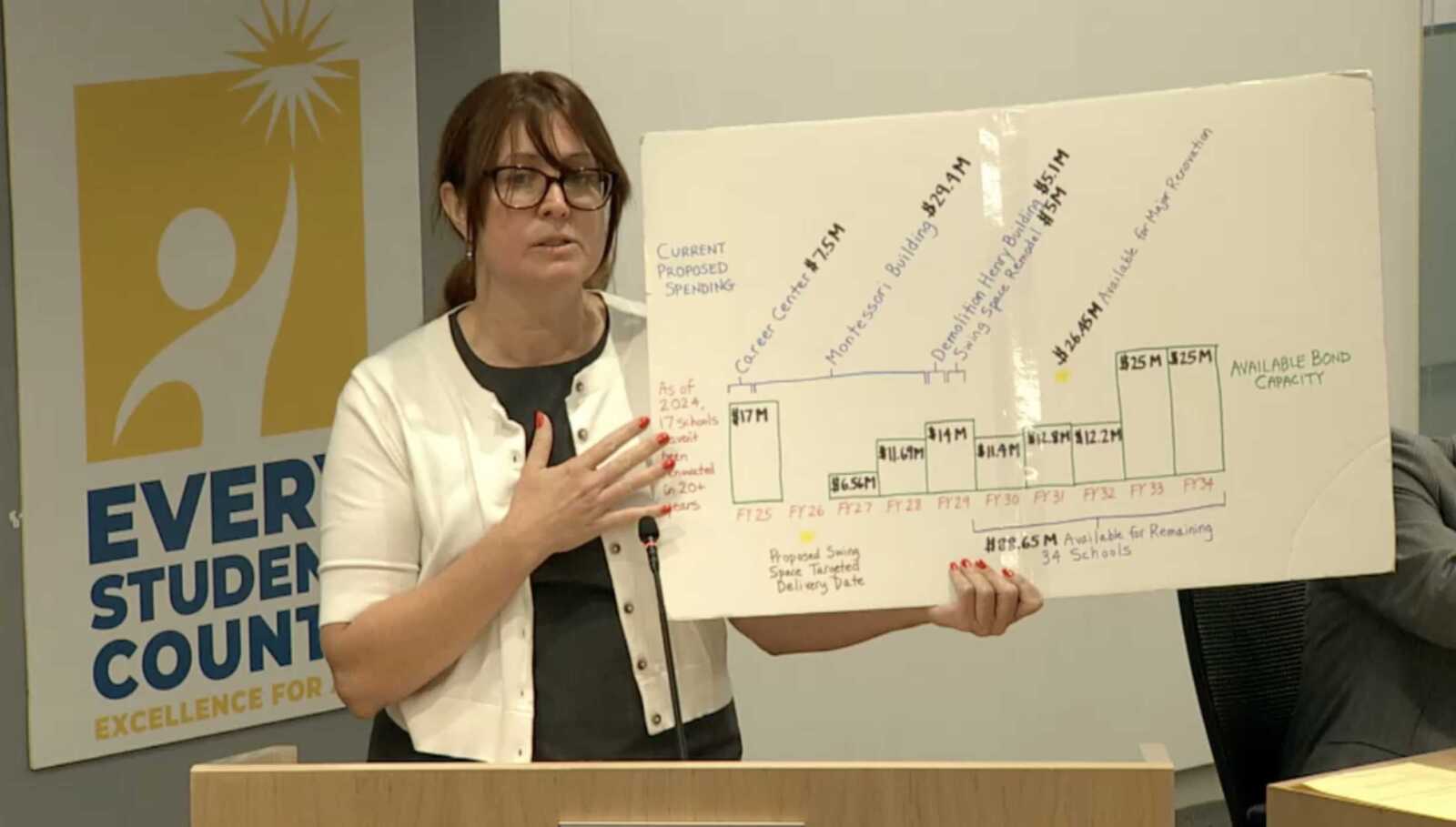
(Updated at 2:30 p.m.) The Arlington County Council of PTAs is criticizing plans to close Nottingham Elementary School and make it a “swing space” where students go when their school is being renovated.
In suggesting this change, the coalition of PTAs, or CCPTA, says Arlington Public Schools has not considered how little money it has in the next decade to spend on sorely needed renovations. It adds the move would disadvantage low-income, diverse neighborhoods that rely on schools for county and community-based services.
This spring, APS proposed closing Nottingham, in the Williamsburg neighborhood at 5900 Little Falls Road, and making it a swing space as early as 2026. It was part of a suite of proposed changes to solve for projected capacity imbalances: several schools below Langston Blvd are over-full while their counterparts north of the highway have many empty seats.
Nottingham was chosen because it would cost the least to retrofit — $5 million to expand its ability to receive buses — compared to other schools, county facilities or commercial buildings. APS also argued it would be more fiscally responsible to use the under-capacity buildings it currently has, rather than build a new school.
This proposal quickly rankled current and future Nottingham parents, some of whom argue APS made the decision on faulty projections of falling enrollment. The CCPTA joined their chorus during the School Board meeting last Thursday.
“Recent spending decisions and currently proposed spending projects have monopolized our bond issuance capacity until at least FY 2032, leaving insufficient funding for a major renovation,” CCPTA President Claire Noakes said in a statement released after the meeting.
She notes 17 of 37 school buildings have not had a major renovation in at least 20 years and are in need of upgrades, creating “a backlog of need.”
“The lack of available funds for a major renovation will cause the swing space to stay empty for six years, while other identified needs that could have been paid for with that $5 million will go unmet,” she continued.
The CCPTA illustrated its argument in a chart that shows how much money APS estimates it can issue in bonds for major renovations over the next decade.
It estimates a major renovation would exceed $25 million, based on estimates for one such project down the pike. The CCPTA say that APS would have to accumulate a few years of bond capacity, from Arlington County, to embark on a major renovation.
This squeeze is due to projects APS already has in the queue, including the new, forthcoming $180 million Arlington Career Center building and related plans to retrofit the current Career Center for the Montessori program now housed in the former Patrick Henry Elementary School. This building is set to be demolished and turned into a green space.
(Note: The chart below lists $7.5 million for the Career Center because this was tacked onto the project’s costs after APS approved the project via the previous Capital Improvement Plan.)
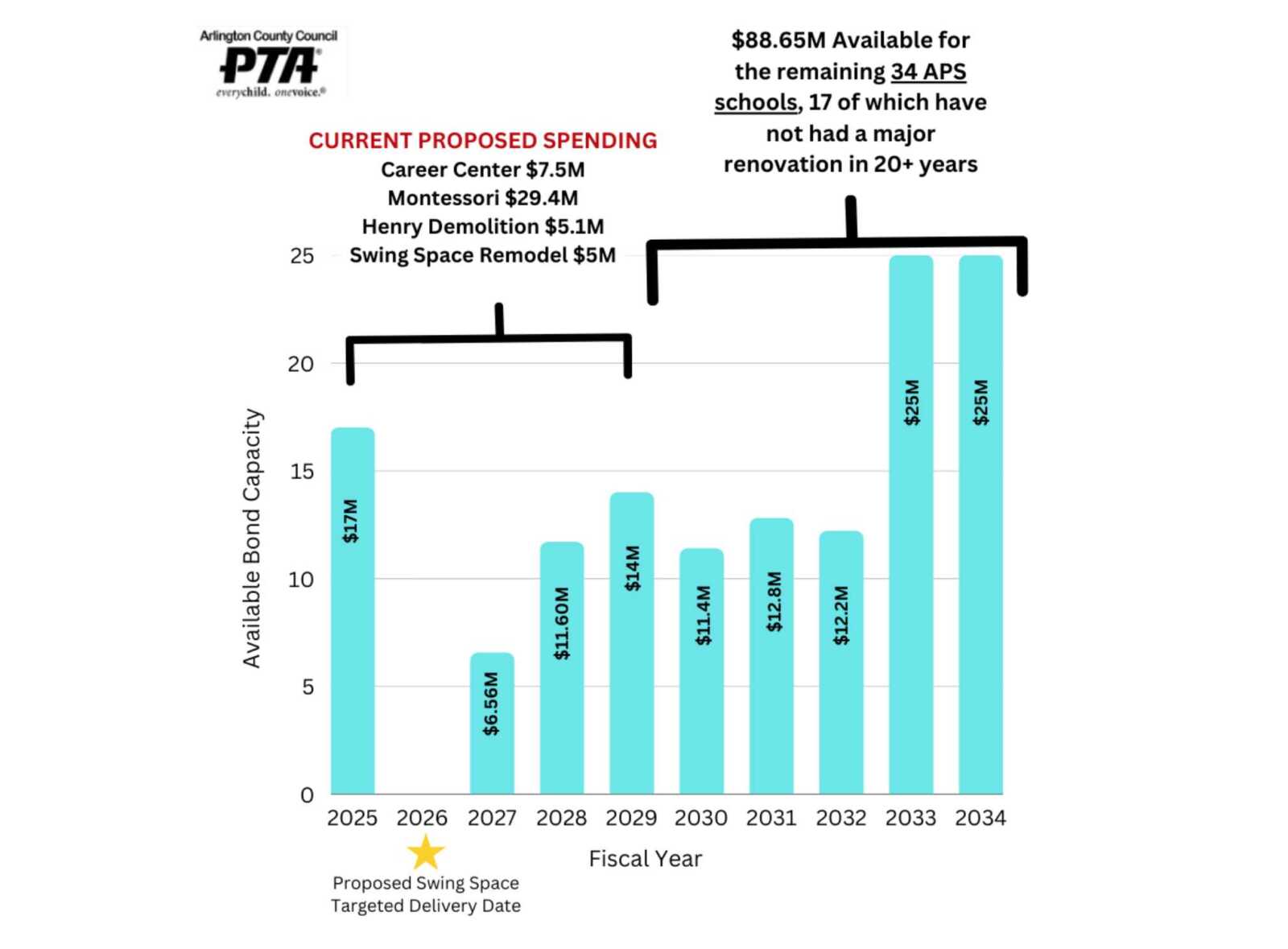
The YMCA may be ditching tennis courts when it redevelops its property in Virginia Square.
The organization plans to tear down its facility at 3400 13th Street N. and build a new recreational facility with an aquatics center, a multi-purpose gym with workout rooms, and a “diversity and inclusion center.”
There will also be a seven-story apartment building with 374 units, as well as open spaces and footpaths through the site.
Tennis players, however, have watched the eight existing courts get cut in half in the plans — and now axed — just ahead of the next project planning meeting set for today (Thursday). After this meeting, the project will head to the Arlington Planning Commission and County Board later this year.
In a letter to members sent last week, and in comments to ARLnow on Tuesday, the organization says it must change course because planning guidance prevents it from building a structure tall enough to accommodate courts.
Without support for the taller heights from Arlington County and neighbors, it says the courts will be scrapped and it plans to work with Arlington to contribute to tennis amenities elsewhere.
“Over the course of multiple reviews of the site plan with the county and the community, the Y and our development partner came to the conclusion we had to reduce the overall footprint of the building,” said Alison Risso, the communications director of YMCA of Metropolitan Washington. “Tennis courts require a substantial amount of horizontal and vertical space while only typically serving two to four players at a time on a court.”
The decision shocked some tennis players, including Janet Barsy.
“The eight Y indoor courts are the last public indoor tennis courts in Arlington,” she said. “They are well used by Arlington and other Northern [Virginia] residents for personal and organized tennis and provide a venue for many popular adult and children’s clinics.”
Barsy says she is dismayed by what she feels is a lack of meaningful engagement with players, who were not pleased by the initial plans, which proposed a reduction in courts. Early public feedback included comments from several tennis players advocating for more courts and fewer bells and whistles.
“Early and honest engagement would have been in keeping with the Y’s four stated core values: caring, honesty, respect and responsibility,” she said.
Risso, however, notes tennis membership “has continued to decline over the last decade,” perhaps replaced by pickleball fever. The proposed facility’s multi-purpose gym includes three indoor pickleball courts and convertible courts for squash, handball and racquetball.
For the county’s part, communications and engagement specialist Elise Cleva says staff flagged that the proposed site layout was “inconsistent with what was envisioned” in a planning document guiding redevelopment along Washington Blvd and N. Kirkwood Road.
The document was precipitated by plans to redevelop the YMCA facility as well as the American Legion and Mill Creek Residential sites to its south.
Moore’s Barber Shop, in Arlington’s historically Black neighborhood of Halls Hill, has survived Covid and remained in business despite competition from low-cost chains.
Its secret, according to owner James Moore Jr., is not a business strategy or particularly talented barber — it is community. In a video (below) produced by Arlington County recently, he muses this must be what motivated his local government to offer to support in any way it could.
“I was like, ‘Why would they do that for me?’ It’s not just because we’re a legacy business. We’ve been here a long time,” he said. “It must have value to the community. It has something intangible that is more than just a good haircut.”
His barbershop is tucked into a nondescript, two-story brick building painted gray at 4807 Langston Blvd. Built in the 1940s, it is a few blocks from the shop his father, James Moore, Sr., opened in 1960.
The current barbershop does not exemplify a grand architectural style but — judging by the video and its prominent place in a draft Historic and Cultural Resources Plan — Arlington County sees in it a cultural landmark worth preserving.
The vehicle for preserving Moore’s Barber Shop would be this new draft plan, released by Arlington County Historic Preservation Program (HPP) staff. It lists the goals they have for preserving storied places and animating them for residents and visitors today. People can provide input on the draft plan this summer via open houses, pop-up events and an online questionnaire. The Arlington County Board could adopt it this fall.
The draft reckons with a historic approach that saved architecturally significant homes but abandoned to development landmarks associated with ethnic groups, like the Vietnamese enclave of Little Saigon, now Clarendon. In the plan, Arlington commits to highlighting diverse stories, saving modest buildings where history happened — like Moore’s Barber Shop — and making preservation relevant.
“Populations and their stories cannot be only (and comprehensively) expressed through architecturally significant buildings, but rather through a varied collection of landscapes and open spaces, public buildings, modestly built neighborhoods, and iconic structures,” the plan says.
“People and culture are key to understanding our environment and the work of historic preservation; as such, they are at the heart of the Plan’s Statement of Historical and Cultural Significance,” it continues.
The draft grapples with the drumbeat of development and HPP’s mixed success saving buildings. Successes include adding historical installations at Dorothy Hamm Middle School, the site of the first Arlington school to racially integrate, and the under-construction Fire Station 8, which Black residents started to put out their own fires when the county would not during the Jim Crow era.
HPP notes, however, some recent demolitions: the Wilson School, now the H-B Woodlawn Secondary Program in Rosslyn; Arlington Presbyterian Church, now affordable housing; the Arlington Education Center, now the Washington-Liberty Annex; the Febrey-Lothrop Estate and the Fellows-McGrath House, which will be replaced with single-family homes.
(Updated at 6:20 p.m.) Post-pandemic, the Ballston Business Improvement District says it will do what it takes to entice remote workers back to the office and attract new residents.
Like other business districts across the country, Ballston has had to weather a slow return-to-work environment as well as permanent changes to where, and how, people work. Compared to peer districts, like downtown D.C., the BID says Ballston was buoyed by a influx of young, highly educated and high-earning residents, who choose to live there for its walkability and transit access.
“Ballston continued to grow throughout the pandemic, and we’re still growing,” BID CEO Tina Leone said last Wednesday during the organization’s annual meeting. “New businesses, new developments and more residents have been joining our community.”
The pandemic drove up the office vacancy rate in Ballston to 24% earlier this year, as some employers abandon offices entirely. For other companies signing leases, demand increased for newer office buildings with a host of perks for workers.
Today, there are 942 total businesses in the neighborhood, including 114 retailers, according to the BID. Some 20,000 employees work in Ballston and about 15,000 people call it home, for a 1.4-to-1 employee-resident ratio.
While lauding its success, the BID is charting its course out of the pandemic and the financial uncertainty it caused. Its leaders say they are focused on helping businesses reconnect with their employees, facilitating renovations to aging office buildings and creating a neighborhood where people want to live.
“We want to understand what our employers want and then more importantly what their employees want. We expect to attract both parties to our market and keep them here,” Board President Simon Carney said. “To do this we need to listen, understand and execute in an ordinated manner. We must be looking at the long term.”
One way the BID supports local businesses, Leone says, is through its Ballston Business Appreciation Campaign, which allows workers to attend free in-office events. It is also open to apartment buildings. Interested employers and apartment management companies need only to fill out a general form online.
“Our business appreciation campaign has helped businesses re-engage with their employees through custom events like breakfasts, lunches, a unique happy hour, wellness events or trivia,” Leone said. “We’ll do whatever they need to come back.”
Meanwhile, Arlington Economic Development Director Ryan Touhill emphasized the role of renovation work to existing, vacant office buildings to attract new tenants. Recent examples of this include the Ballston Point building (4300 Wilson Blvd), which netted new occupants, and Three Ballston Plaza (1100 N. Glebe Road), where work is underway.
Touhill says the BID can help more office building owners take on similar improvements.
It has been about 10 months since Arlington County released drawings of a future Langston Blvd.
That vision included apartment buildings of up to 12-15 stories, cafés and wide sidewalks buzzing with people, and bike lanes buffered by lavender bushes — a substantial change from the commuter route lined with strip malls, car dealerships and quick-service establishments with drive-thru windows.
Now, the county is gearing up to publish a more formal draft plan that refines the ideas set forth last year. That draft will take into account all the supportive and critical feedback people submitted last fall and winter.
Once the draft is released — and exact details and dates on this are yet to be determined — there will be more public engagement opportunities, Dept. of Community Planning, Housing and Development communication specialist Rachel LaPiana tells ARLnow.
The multi-year effort to create this planning document is known as Plan Langston Blvd. It re-envisions what was once known as Lee Highway as a walkable and bikeable, verdant commercial corridor with more affordable housing.
After hearing hundreds of hours of comments from residents, and a decade’s worth of work, Langston Blvd Alliance Executive Director Ginger Brown says she is excited to get her hands on the draft plan soon.
“We know this is a huge step forward,” she said. “We’re very eager to see the final draft plan.”
The draft plan is supposed to be informed by community and commission input but in many cases, that input is deeply divergent, according to snippets of comments included in a summary of public engagement year.
“If we wanted to live in denser, taller neighborhoods we would have moved to [Rosslyn],” wrote one person. “Stop forcing your vision of redevelopment down residents throats.”
“As a working professional with a young child, I look forward to eventually being able to buy a house in Arlington as a result of projects like this one,” wrote another. “Please ignore grumpy people who hate change and implement this plan!”
There were some points of agreement.
People generally want to see a safer Route 29 — the other name for the VDOT-maintained artery — with more street trees and wider sidewalks, as well as underground utilities and fewer driveways. Some wrote in strong support for protected bike lanes over cyclists and drivers sharing lanes, a traffic pattern that may harm, not help, cyclists.
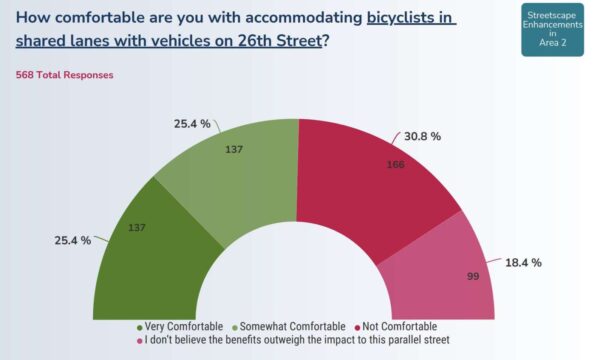
“We’d like to see a greater emphasis on pedestrian safety and transportation and transit improvements and more affordable housing,” Brown said.
Majority support for greater development broke down somewhat when it came to what buildings should look like.
“People in my neighborhood are looking for development similar to the unified and attractive character of King Street in Old Town [Alexandria], not the development and tall buildings that characterize Ballston or Clarendon,” wrote one person.
“We should allow 15 stories for all sites between Langston & [I-66],” wrote another. “This could provide so many amenities and increase property values.”
For instance, where Route 29 is bordered by the Waverly Hills, Donaldson Run, Old Dominion, Glebewood and Waycroft Woodlawn neighborhoods, a slight majority favored taller heights — with many others preferring a range of other, shorter options.
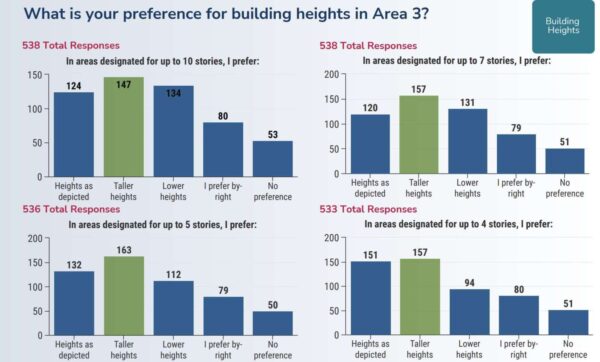
In response to criticism from residents, citizen commissioners and county staff, a developer has removed a drive-thru ATM from its plans to redevelop the Wells Fargo in Clarendon.
One year ago, McLean-based developer Jefferson Apartment Group filed plans to replace the bank — the one someone recently attempted to rob — with a mixed-use building. It is set to consist of 238 apartments, 60,000 square feet of office space and 30,000 square feet of retail, including a new Wells Fargo branch.
The current two-story bank building at 3140 Washington Blvd has a drive-thru in addition to a surface parking lot. Critics of keeping the drive-thru say it would detract from walkability in the area, which is seeing significant redevelopment that will result in more people living, shopping and using public amenities in Clarendon.
“This is the most walkable place in the county and drive-up for anything doesn’t make sense to me,” said Planning Commission member Jim Lantelme back in February. “You would have to have a second ATM that people could walk up to.”
One commenter said drive-thrus are “horrible for the environment and they aren’t faster than parking and going into the building,” while another called it “a relic of the 70s [that] doesn’t belong here.”
A third said it “seems like a very bad idea that will take away space from pedestrians and increase the chance of crashes and congestion in an area that is meant to be dense and walkable.”
Jefferson had originally doubled down on the drive-thru ATM, saying in a county document this was “for the convenience of existing customers and as requested by Wells Fargo based on customer feedback during and after the pandemic.”
Ultimately, it agreed to changes that resemble a suggestion from the Clarendon Courthouse Civic Association: walk-up ATMs and free, short-term parking on a new local street that Jefferson will construct as part of the project.
The walk-up ATMs will be located at the northern and southern edges of the bank, which looks out over N. Irving Street. This street, which dead-ends in a green space, is set to become a plaza through a separate, Dept. of Parks and Recreation-led planning process.
People using the ATMs will be able to park in short-term parking on the north side of a planned public road. As part of the project, Jefferson will build a new 10th Road N., which will run parallel to Washington Blvd and separate the new construction from the existing Verizon building to the south.
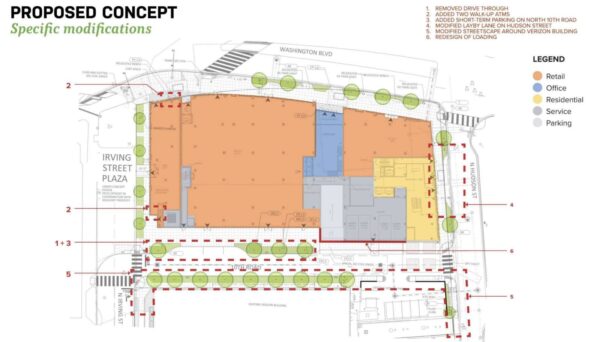
Even with the walk-up ATMs, staff have concerns that a bank, generally, is not the kind of lively retail that encourages people to use the planned Irving Street Plaza. Those who commented were not as concerned with this but suggested sculptures or water features could help “activate” the plaza.
Although redevelopment plans for the mid-century Inn of Rosslyn pay homage to the motel, the county says the developer could do more.
Last fall, D.C. real estate company Monument Realty filed plans to replace the 38-unit hotel, built in 1957, with an 8-story, 141-unit apartment building with 88 parking spaces. It took over the property after JBG Smith purchased it in December 2020.
This February, the county kicked off a review process that will culminate with a vote by the Arlington County Board. Planning staff already have some suggestions for the developer to comply with recommendations for the site made in the neighborhood’s Fort Myer Heights North Plan.
They say Monument should study adding floors to shrink the overall footprint of the property — located at 1601 Fairfax Drive, fronting Route 50 — match it to heights of other nearby apartment towers.
The designs, meanwhile, should imitate nearby Art Deco and Colonial Revival garden apartments and the developer could incorporate more historic preservation of the property, county planners say.
“The building footprint should be reduced to provide the recommended landscaped green space which is not currently provided,” said planners in a county report. “The proposed building does not incorporate elements of Colonial Revival or Art Deco, as recommended.”
New renderings from Monument Realty depict a building with alternating stripes of lighter and darker brick, offset by wood-like paneling. Mid-century motifs on the balconies and a “50” sign out front pay homage to the architecture of the existing hotel.
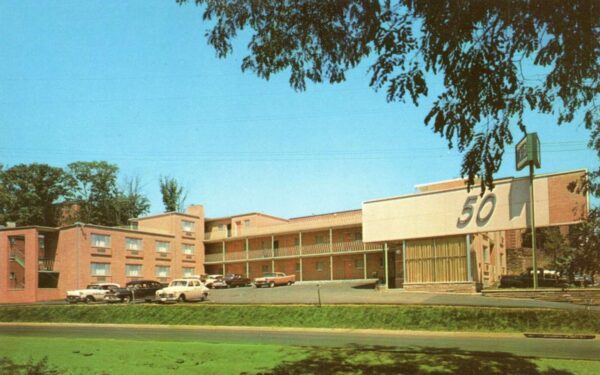
The developer’s land use attorney, Nick Cumings of Walsh Colucci Lubeley & Walsh, argued in a January 2023 letter to the county that the project does “compliment and draw from the architecture of the existing building and the characteristics of the surrounding neighborhood.”
That includes the retro “50” sign and some of the materials to be used in construction.
“This selection of building materials is appropriate for the neighborhood, which predominantly features masonry, while also introducing a biophilic design with the wood-like paneling,” writes Cumings.
The county also wants the developer to work on “historic preservation elements” for the existing motel, while an attorney for Monument Realty argues that is not necessary.
Within the Arlington County Historic Resources Inventory, Cumings says, the property is designated as “Important” — but less distinctive and/or in worse condition than “Essential.” He added that the neighborhood plan does not call for its historic preservation.
Meanwhile, residents involved in the pro-housing group YIMBYs of Northern Virginia said on social media that their priority will be getting the developer to include more affordable housing in exchange for greater density.
Like staff, they envision the building reaching 12 stories — the tallest the Fort Myer Heights plan allows — so that more people can live in the Metro-accessible area.
Monument Realty already plans to earn some 59,000 square feet of extra density by participating in the Green Building Density Incentive Program, aiming to earn LEED Gold, and by providing some affordable housing. It’s unclear whether the provided affordable housing will be on-site or elsewhere.
Next up in the development approval process, the Site Plan Review Committee of the county’s Planning Commission will review the project twice before it heads to other citizen commissions and the Arlington County Board. No dates have been set for these meetings.
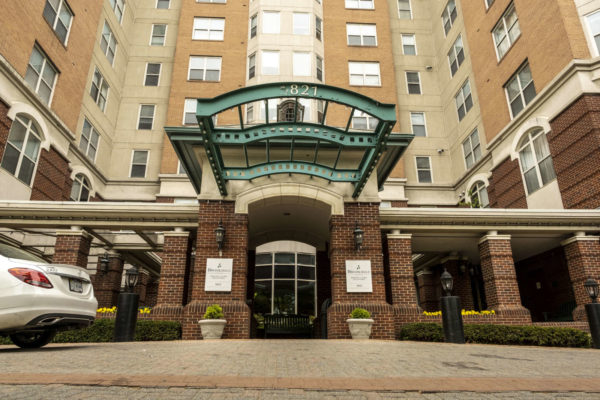
Over the next 25 years, the D.C. area will need to invest more in housing and services tailored toward a rapidly graying population.
That is one of the takeaways from a presentation of job, population and household growth forecasts presented to the Metropolitan Washington Council of Governments today (Wednesday).
Overall, the region is set to gain one million jobs, 1.5 million people and 700,000 new households by 2050.
Job growth may not be as robust as previously projected, with new forecasts projecting 200,000 fewer total jobs for each forecast year, due to the lingering effects of the pandemic and a “dampening” caused by an aging population, COG Community Planning and Services Director Paul DesJardin said.
These forecasts are intended to help local and regional agencies gauge the demand for public infrastructure and transportation. They can also use it to develop policies tackling regional issues — including an aging population.
In 2020, the region had 757,000 people over the age of 65 and, by 2050, this population is projected to swell to 1.2 million, a growth rate of 64%, per the presentation. At the other end of the age spectrum, school-aged children will remain fairly steady, growing from just over 1 million in 2020 to 1.1 million in 2050.
“This is a national and a local trend,” said DesJardin. “Our economic competitiveness is imperative on our ability to attract and maintain talent. Then, there’s the concomitant challenges of the human services an aging population will need. We still have a growing and steady workforce population but we are aging.”
Later, DesJardin said the aging population may also require the construction of more dwellings accessible to those with physical challenges, from single-family detached homes to apartments. That would be part of a continued push to increase housing overall.
“We still do need to do more to address our housing challenge. We need to do more for production, and certainly affordability,” he said.
Arlington County Planning Director Anthony Fusarelli says the county has been preparing for this population shift.
“We in Arlington over the past several years have been focused increasingly more so on the needs of that older population,” he said. “The County Board has approved zoning ordinance amendments to make it easier and provide more flexibility for things such as assisted living and senior living facilities.”
County staff are studying homeownership and will be looking at housing options for seniors. Fusarelli also mentioned the recent adoption of “Missing Middle” zoning changes allowing the by-right construction of 2-6 unit buildings in areas previously reserved for single-family detached homes.
“One of the benefits we see as a community in allowing duplexes or small apartment buildings across much of Arlington that currently isn’t permitted, or hasn’t been permitted historically, is it does provide the opportunity for that aging demographic to expand their property or find another housing unit in the neighborhood they’ve been in for some time that otherwise wouldn’t be there today,” he said.
Overall, he says, the COG forecast plays an important role “in really grounding our community conversations about planning for growth over the next 20-30 years.”
“It’ll account for changes in the ramp-up of Amazon’s headquarters, the Pentagon City Sector Plan — which our County Board adopted more than one year ago, which can potentially double the amount of development in that Metro station area — as well as other studies for our Shirlington area and others as well.”
Arlington County Board Chair Christian Dorsey says this information helps the county explain to constituents why it is always working on a planning project.
“I know it helps us in Arlington address one of the fundamental questions we get in the community. ‘All this stuff you’re planning and doing, what are you solving for?'” Dorsey said. “This really gives us a ‘for’ that we’re trying to solve, and it’s based, really, on the broadest possible set of data for our entire interconnected region.”

While last week‘s landmark zoning decision legalized 2-6 unit homes throughout Arlington’s lowest-density neighborhoods, about 136 properties will be ineligible for such projects.
The exemption applies to certain 5,000-6,000 square-foot lots — the county’s smallest standardized residential lot size, dubbed R-5 and R-6, respectively — located near transit and within planning districts in East Falls Church, Cherrydale and Columbia Pike.
In the nearly 150-page long report on the zoning ordinance changes, Arlington County says the three properties in East Falls Church, 49 properties in Cherrydale and 82 near the Pike could be assembled with other properties that previous planning efforts have identified for redevelopment.
“Within these planning districts, there are locations where reinvestment has not yet occurred and assembly of the R-5 and R-6 zoned parcels with parcels along the corridor frontage could realize identified plan goals for the revitalization district,” per the county report outlining the approved Missing Middle zoning changes.
Assembling these properties with nearby lots could allow developers to realize the vision for these corridors, the report says.
This includes “mixed use development, improvements to the public realm, walkability, increased housing supply, housing affordability, and creation of coordinated buffer or transition zones to lower density residential areas,” the county says.
In East Falls Church, transit-oriented development near the Metro station has languished and many planning goals from a 2011 East Falls Church Area Plan remain unrealized. While there are some new townhouses within walking distance, an empty parking lot and a standalone parking garage are two examples of “prime real estate” awaiting redevelopment.
This includes two single-family homes — across the street from the “Kiss and Ride” lot — identified for potential redevelopment in the 2011 plan, which faced strong opposition from some who said it encouraged too much development, despite the proximity to a Metro station.
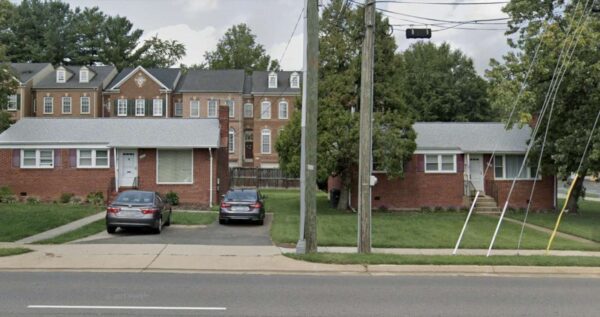
The other exempted property, though zoned as residential, is home to a telecommunications building owned by Verizon and a parking lot. The back of this surface parking lot is across the street from the East Falls Church Metro station; some commuters use it to cut through the block north of the station, per the 2011 plan.
“The Verizon building is anticipated to remain in use for the foreseeable future,” the 2011 plan notes. “However the rear portion of the lot, which is a largely unused parking lot, has potential for redevelopment.”
The plan envisions townhouses or low-rise multifamily development of three to four stories. Verizon did not return a request for comment about plans for the site.
Such development “should accommodate a dedicated pedestrian path through the entire site from Lee Highway to Washington Boulevard that would formalize this vital connection,” the plan says.
If the Virginia Dept. of Transportation and WMATA move forward with plans to redevelop a commuter lot across the street, the connection could also get a new signalized crossing between the — potentially — redeveloped lots. Around this time last year, neither agency indicated progress toward redeveloping the site, citing barriers such as restrictive zoning.
At the time, a county planner told ARLnow that without higher building heights, there may not be much of an incentive to build.
“Those costs are real,” Natasha Alfonso said. “There has to be enough density to justify that kind of improvement on those sites. If the community wants walkable, transit-oriented development, those are things we have to consider.”
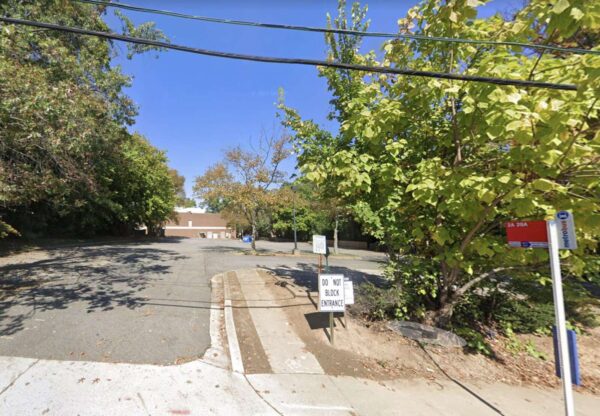
Another 82 properties are located within the Columbia Pike Special Revitalization District, including some along 12th Street S., a few blocks south of the Pike.

